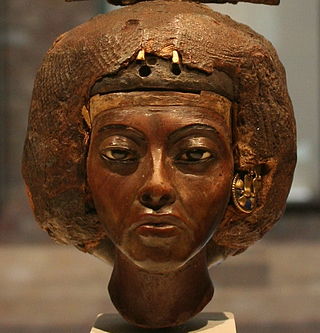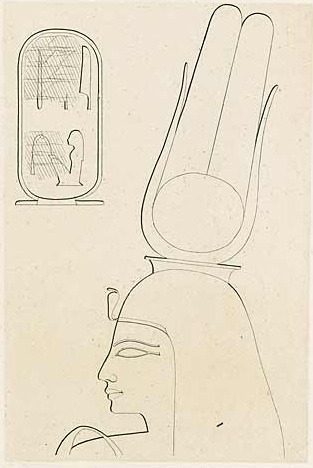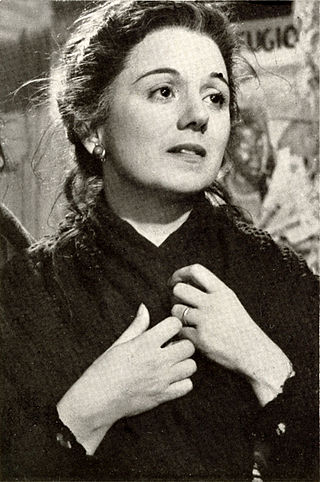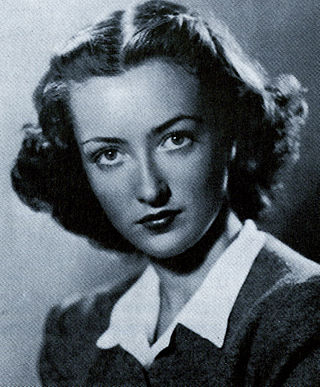
Akhenaten, also spelled Akhenaton or Echnaton, was an ancient Egyptian pharaoh reigning c. 1353–1336 or 1351–1334 BC, the tenth ruler of the Eighteenth Dynasty. Before the fifth year of his reign, he was known as Amenhotep IV.

Nefertiti was a queen of the 18th Dynasty of Ancient Egypt, the great royal wife of Pharaoh Akhenaten. Nefertiti and her husband were known for their radical overhaul of state religious policy, in which they promoted the earliest known form of monotheism, Atenism, centered on the sun disc and its direct connection to the royal household. With her husband, she reigned at what was arguably the wealthiest period of ancient Egyptian history. After her husband's death, some scholars believe that Nefertiti ruled briefly as the female pharaoh known by the throne name, Neferneferuaten and before the ascension of Tutankhamun, although this identification is a matter of ongoing debate. If Nefertiti did rule as pharaoh, her reign was marked by the fall of Amarna and relocation of the capital back to the traditional city of Thebes.

Tiye was the Great Royal Wife of the Egyptian pharaoh Amenhotep III, mother of pharaoh Akhenaten and grandmother of pharaoh Tutankhamun; her parents were Yuya and Thuya. In 2010, DNA analysis confirmed her as the mummy known as "The Elder Lady" found in the tomb of Amenhotep II (KV35) in 1898.

Tadukhipa, in the Hurrian language Tadu-Hepa, was a princess of the Mitanni kingdom. The daughter of King Tushratta of Mitanni and his queen Juni, and niece of Artashumara. Tadukhipa's aunt Gilukhipa had married Pharaoh Amenhotep III in his 10th regnal year. Tadukhipa was to marry Amenhotep III more than two decades later.

Tey was the Great Royal Wife of Kheperkheprure Ay, who was the penultimate pharaoh of Ancient Egypt's Eighteenth Dynasty. She also had been the wet nurse of Nefertiti.
Carlo Rustichelli was an Italian film composer whose career spanned the 1940s to about 1990. His prolific output included about 250 film compositions, as well as arrangements for other films, and music for television.

Atenism, also known as the Aten religion, the Amarna religion, and the Amarna heresy, was a religion in ancient Egypt. It was founded by Akhenaten, a pharaoh who ruled the New Kingdom under the Eighteenth Dynasty. The religion is described as monotheistic or monolatristic, although some Egyptologists argue that it was actually henotheistic. Atenism was centred on the cult of Aten, a god depicted as the disc of the Sun. Aten was originally an aspect of Ra, Egypt's traditional solar deity, though he was later asserted by Akhenaten as being the superior of all deities. In the 14th century BC, Atenism was Egypt's state religion for around 20 years, and Akhenaten met the worship of other gods with persecution; he closed many traditional temples, instead commissioning the construction of Atenist temples, and also suppressed religious traditionalists. However, subsequent pharaohs toppled the movement in the aftermath of Akhenaten's death, thereby restoring Egyptian civilization's traditional polytheistic religion. Large-scale efforts were then undertaken to remove from Egypt and Egyptian records any presence or mention of Akhenaten, Atenist temples, and assertions of a uniquely supreme god.

Massimo Serato was an Italian film actor with a career spanning over 40 years.

Clelia Matania was an Italian film and voice actress.

The Captain's Daughter is a 1947 Italian historical adventure film directed by Mario Camerini and starring Irasema Dilián, Amedeo Nazzari and Vittorio Gassman. It was one of a number of ambitious historical epics made in the wake of the successful 1946 film The Black Eagle. The film's sets were designed by the art director Piero Filippone. It was entered into the 1947 Cannes Film Festival. It is based on the 1836 novel of the same name by Alexander Pushkin, which is set in Russia during the reign of Catherine II. It takes place during the Cossack Rebellion.

Maurizio Arena was an Italian film actor. He appeared in more than 70 films between 1952 and 1978.

Guy Gilles was a French film director.

La figlia del diavolo or La fille du diable is a 1952 French-Italian historical drama film directed by Primo Zeglio and starring Massimo Serato, Paola Barbara, and Marina Vlady.

The Younger Lady is the informal name given to an ancient Egyptian mummy discovered within tomb KV35 in the Valley of the Kings by archaeologist Victor Loret in 1898. The mummy also has been given the designation KV35YL and 61072, and currently resides in the Egyptian Museum in Cairo. Through recent DNA tests, this mummy has been identified as the mother of the pharaoh Tutankhamun and a daughter of pharaoh Amenhotep III and his Great Royal Wife Tiye. Early speculation that this mummy was the remains of Nefertiti was argued to be incorrect, as nowhere is Nefertiti accorded the title "King's daughter."

The Eighteenth Dynasty of Egypt is classified as the first dynasty of the New Kingdom of Egypt, the era in which ancient Egypt achieved the peak of its power. The Eighteenth Dynasty spanned the period from 1550/1549 to 1292 BC. This dynasty is also known as the Thutmoside Dynasty) for the four pharaohs named Thutmose.
Nefertiti was the Great Royal Wife of Egyptian pharaoh Akhenaten.
Daniel Duval was a French film actor, director and writer.

Gaston Velle (1868–1953) was a French silent film director and pioneer of special effects, who was prominent in early French and Italian cinema during the first two decades of the 20th century. Like his father, the Hungarian entertainer Joseph "Professor" Velle, Gaston began his career as a travelling magician, before putting his illusionist skills to work in cinema and ultimately creating more than fifty films between 1903 and 1911. He worked under Auguste and Louis Lumière, before serving as the head of production for the Italian film studio Cines. But he is best remembered for his work at Pathé, where he was hired to produce trick films that might rival those of his contemporary, Georges Méliès, including classic shorts like Burglars at Work (1904). Some films pioneered lasting techniques, such as his Les Invisibles (1906) – the first known invisible man film.

Ipy, also transliterated as Apy, was a court official from the time of Amenhotep III and Akhenaten during the Egyptian 18th Dynasty. Ipy was High Steward of Memphis, and a royal scribe.

Michela Schiff Giorgini Paleologo Diana née Beomonte was an Italian egyptologist and actress, who is remembered for her extensive work in today's Sudan at Soleb on the River Nile where from 1957 she conducted excavations of the Temple of Amenhotep III. During the 20 years she spent in the area, she went on to investigate the temple of Queen Tiye at Sedeinga, and the tomb of Taharqa at Nuri. The Michela Schiff Giorgini Foundation was established in 1984 to preserve her memory and promote Egyptology. Her research is well documented in her many books and publications, beginning with Soleb: Volume 1 in 1965.

















